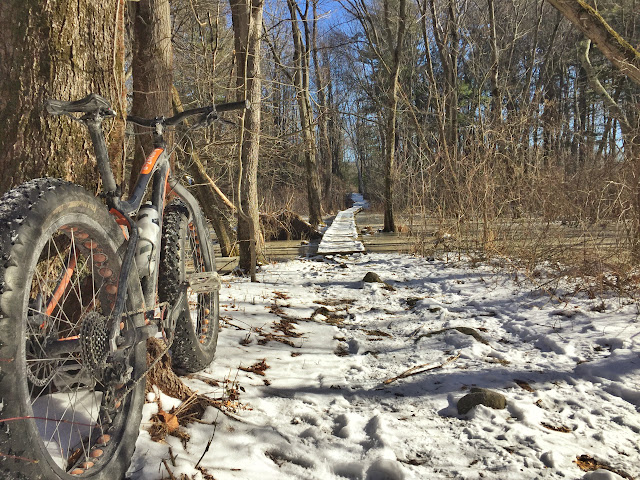It was about this time last year that I carving lines in deep untracked powder through the woods in the Blue Hills. Those were the days- "were” being the operative word.
As if a look out the window wasn’t enough to nail home the sad state of the snowpack, this morning’s long term forecast is calling for temperatures in the 40’s for the foreseeable future. While there's still plenty of winter left to fulfill our backcountry skiing plans, the next few weeks aren't looking so good. But like anything in life, you can sit home and cry in your Cheerios or you can adapt, evolve, and find a silver lining. If you’re a winter outdoor enthusiast, you may need a fat bike to mine that vein of silver.
 |
| My fat buddy. |
In the months since I bought it, I’ve taken it out on a number of rides in all sorts of conditions and have gotten a feel for the character of the bike and have some observations to make. If you’ve been on the fence about jumping onto the fat bike bandwagon, let me tell you what I’ve found.
 |
| Oh the places you will go. |
 |
| Ahh, the warm days of December. December?!! Wtf? |
 |
| All tracked out the day after the storm. |
Studs or no studs, things get especially slippery when you’re trying to ride on unconsolidated powder snow or corn snow that is loose. Where the bike really shines is when the snow has been packed down and hardened overnight. While this requires a groomer or army of snowshoers in some places, the Boston burbs are blessed with enough traffic so that all the local trails have been packed by the day after a storm.
As far as I can tell, the real weather “sweet spot” for riding is temperatures in the 20’s, sunny and calm winds. Even on days when the temperatures are going to hit 40F or (gasp) 50F, it is usually below freezing in the early morning. That is when you want to be out riding. Frozen dirt or snow is perfect for fat biking, while mud and slush are pretty miserable. So get out early on those days.
I carry a water bottle that I fill with hot Gatorade before my rides. My bottle is insulated like this one so it stays relatively warm and has yet to freeze even on long rides.
 |
| Wear a helmet, kids. |
For my legs, I wear my Ibex wool "El Fito" bike tights, and these EMS Northshield pants. They’ve worked really nicely and seem like they would be warm enough to wear down to at least 10 degrees. Any colder and I would likely add a layer of insulation.
For gloves, I’ve been wearing windstopper gloves, which work down to about 20 degrees as well. Any colder and I would need to add insulation and mittens.
 |
| Sunny skies and firm snow. What more do I need? |
One absolutely essential piece of equipment is a buff, like this multiclava from Eddie Bauer or this one from EMS. These are handy to keep your face from freezing up like one of those White Walkers from Game of Thrones.
All in all, I've been pretty comfortable on the bike and have loved the combination of biking and sledding. Even the local trails feel brand new and exciting.
Perhaps the most interesting thing about riding a fat bike that I’ve found is the fact that people talk to me all the time while I’m out riding—and not just to say “nice lycra fatty!” I’m not sure what it is about fat tires that invites conversation, but maybe it has to do with the big smile on my face when I’m out riding it around on a brilliant winter day.
 |
| Icy bridges are less terrifying. |


Gotta be the first time i've ever seen GBF/Tophet ever mentioned in an article lol
ReplyDeletei'll be there Sunday...
tho not on a fat bike :-( its on the list!